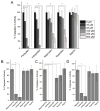Non-steroidal Anti-inflammatory Drugs Are Caspase Inhibitors
- PMID: 28238723
- PMCID: PMC5357154
- DOI: 10.1016/j.chembiol.2017.02.003
Non-steroidal Anti-inflammatory Drugs Are Caspase Inhibitors
Abstract
Non-steroidal anti-inflammatory drugs (NSAIDs) are among the most commonly used drugs in the world. While the role of NSAIDs as cyclooxygenase (COX) inhibitors is well established, other targets may contribute to anti-inflammation. Here we report caspases as a new pharmacological target for NSAID family drugs such as ibuprofen, naproxen, and ketorolac at physiologic concentrations both in vitro and in vivo. We characterize caspase activity in both in vitro and in cell culture, and combine computational modeling and biophysical analysis to determine the mechanism of action. We observe that inhibition of caspase catalysis reduces cell death and the generation of pro-inflammatory cytokines. Further, NSAID inhibition of caspases is COX independent, representing a new anti-inflammatory mechanism. This finding expands upon existing NSAID anti-inflammatory behaviors, with implications for patient safety and next-generation drug design.
Keywords: NSAIDs; anti-inflammation; caspase; pharmacology.
Copyright © 2017 Elsevier Ltd. All rights reserved.
Figures





Similar articles
-
Novel Activities of Select NSAID R-Enantiomers against Rac1 and Cdc42 GTPases.PLoS One. 2015 Nov 11;10(11):e0142182. doi: 10.1371/journal.pone.0142182. eCollection 2015. PLoS One. 2015. PMID: 26558612 Free PMC article.
-
Variation of the aryl substituent on the piperazine ring within the 4-(piperazin-1-yl)-2,6-di(pyrrolidin-1-yl)pyrimidine scaffold unveils potent, non-competitive inhibitors of the inflammatory caspases.Bioorg Med Chem Lett. 2016 Nov 15;26(22):5476-5480. doi: 10.1016/j.bmcl.2016.10.025. Epub 2016 Oct 12. Bioorg Med Chem Lett. 2016. PMID: 27777011
-
Biodegradable polyesters containing ibuprofen and naproxen as pendant groups.Biomacromolecules. 2013 Oct 14;14(10):3542-8. doi: 10.1021/bm400889a. Epub 2013 Sep 6. Biomacromolecules. 2013. PMID: 23957612 Free PMC article.
-
Small Molecule Active Site Directed Tools for Studying Human Caspases.Chem Rev. 2015 Nov 25;115(22):12546-629. doi: 10.1021/acs.chemrev.5b00434. Epub 2015 Nov 9. Chem Rev. 2015. PMID: 26551511 Free PMC article. Review.
-
[A novel class of anti-inflammatory and analgesic drugs--NO-donating NSAIDs].Yao Xue Xue Bao. 2007 Apr;42(4):352-7. Yao Xue Xue Bao. 2007. PMID: 17633199 Review. Chinese.
Cited by
-
NF-κB and Pancreatic Cancer; Chapter and Verse.Cancers (Basel). 2021 Sep 7;13(18):4510. doi: 10.3390/cancers13184510. Cancers (Basel). 2021. PMID: 34572737 Free PMC article. Review.
-
Smoking enhances proliferation, inflammatory markers, and immunoglobulins in peripheral blood mononuclear cells from Graves' patients.Endocr Connect. 2024 May 6;13(6):e230374. doi: 10.1530/EC-23-0374. Print 2024 Jun 1. Endocr Connect. 2024. PMID: 38614122 Free PMC article.
-
Neurovascular Unit Alterations in the Growth-Restricted Newborn Are Improved Following Ibuprofen Treatment.Mol Neurobiol. 2022 Feb;59(2):1018-1040. doi: 10.1007/s12035-021-02654-w. Epub 2021 Nov 26. Mol Neurobiol. 2022. PMID: 34825315
-
Applying deductive reasoning and the principles of particle physics to aging research.Aging (Albany NY). 2021 Sep 20;13(18):22611-22622. doi: 10.18632/aging.203555. Epub 2021 Sep 20. Aging (Albany NY). 2021. PMID: 34543232 Free PMC article.
-
A compendium of kinetic modulatory profiles identifies ferroptosis regulators.Nat Chem Biol. 2021 Jun;17(6):665-674. doi: 10.1038/s41589-021-00751-4. Epub 2021 Mar 8. Nat Chem Biol. 2021. PMID: 33686292 Free PMC article.
References
-
- Ashburn TT, Thor KB. Drug repositioning: identifying and developing new uses for existing drugs. Nat Rev Drug Discov. 2004;3:673–683. - PubMed
-
- Creagh EM. Caspase crosstalk: Integration of apoptotic and innate immune signalling pathways. Trends Immunol. 2014;35:631–640. - PubMed
-
- Denault J-B, Salvesen GS. Current Protocols in Protein Science. Hoboken, NJ, USA: John Wiley & Sons, Inc; 2002. Expression, Purification, and Characterization of Caspases; pp. 21.13.1–21.13.15. - PubMed
MeSH terms
Substances
Grants and funding
LinkOut - more resources
Full Text Sources
Other Literature Sources
Research Materials

